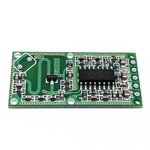harvie
Full Member level 1
In recent years i've noticed rise of extremely cheap motion detectors based on doppler effect in RF domain. There are lots of them, one example looks like this:

To my knowledge there are 3 main blocks to it:
* some black magic RF PCB design
* single transistor with few passives working as TX oscillator and RX mixer at the same time
* some generic PIR motion detecting IC repurposed to work with RF instead of PIR (provides monostable latching and clean output to drive external circuitry). It's very suprising, but it seems that the IC doesn't really execute any doppler detection, it just provides nice long pulse once it's triggered by the RF frontend.
I would like to implement this myself, given that i don't have pretty much any RF design experience.
I want to only take the RF block with PCB and transistor and couple it directly to Arduino or ESP32 input to handle the latching, so i can reduce part count and easily tune the sensitivity in my firmware. I need to shrink this circuit to minimal size, which should be possible, given the fact that only half of the PCB does actual job and rest is there just for convenience.
Do you think this is possible? Given that i will COPY the existing RF PCB design and only replace the logic with my own uC. Also i might want to slightly modify the PCB design to tune it for thicker 1.6mm FR4 board.
Let's say i want to design my own arduino board on 1.6mm FR4 with doppler motion sensor without the intermediate PIR IC. Maybe replace the PIR IC with schmitt trigger or opamp and handle output by arduino interrupt. So i can trigger the motion detected if i get N pulses per second (where N is tunable according to desired sensitivity)
Any ideas where should i begin?

To my knowledge there are 3 main blocks to it:
* some black magic RF PCB design
* single transistor with few passives working as TX oscillator and RX mixer at the same time
* some generic PIR motion detecting IC repurposed to work with RF instead of PIR (provides monostable latching and clean output to drive external circuitry). It's very suprising, but it seems that the IC doesn't really execute any doppler detection, it just provides nice long pulse once it's triggered by the RF frontend.
I would like to implement this myself, given that i don't have pretty much any RF design experience.
I want to only take the RF block with PCB and transistor and couple it directly to Arduino or ESP32 input to handle the latching, so i can reduce part count and easily tune the sensitivity in my firmware. I need to shrink this circuit to minimal size, which should be possible, given the fact that only half of the PCB does actual job and rest is there just for convenience.
Do you think this is possible? Given that i will COPY the existing RF PCB design and only replace the logic with my own uC. Also i might want to slightly modify the PCB design to tune it for thicker 1.6mm FR4 board.
Let's say i want to design my own arduino board on 1.6mm FR4 with doppler motion sensor without the intermediate PIR IC. Maybe replace the PIR IC with schmitt trigger or opamp and handle output by arduino interrupt. So i can trigger the motion detected if i get N pulses per second (where N is tunable according to desired sensitivity)
Any ideas where should i begin?